Here, just for kicks, is a small resume of my adventures with Karlson enclosures. Most of these were lost to Imageshack, so I though I'd re-post.
Not all of it is fullrange and 100% on-topic, but this is the one place where Karlson fans seem to hang out most.
I first built a pair of K5 in 2011 or so. These are scaled-down from the factory K8 design. Hard to see in the below picture, but they used a Pioneer A11 4.5" fullrange.
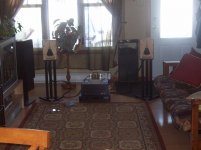
I then purchased the last pair of FF125K at Solen (most likely in all of Canada) before they were discontinued. These were better-suited than the A11, which is a bit of a boring driver itself.
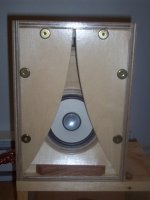

The last configuration I tried with the K5 was a transformation to an X5, with an internal K-tube. The new midbass driver was a 5.25" Vifa C13, which did reasonably well in there with a venting mod. The slotted waveguide was driven by a tiny inexpensive mylar dome tweeter.
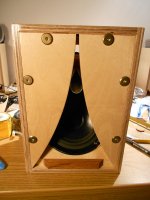
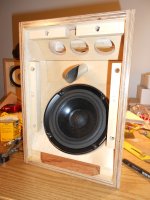
Overall, the K5 was not a success. There never was much bass and the sound was usually congested.
I then decided to go larger and built a pair of Karlsonette. This was the first K12 commercialized by Karlson. I built strictly to factory plans. I had two drivers to mess with in there: the 8" Philips AD9710 and 10" Richard Allan CG10T.
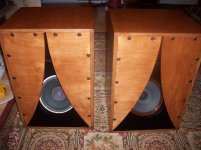
The CG10T did somewhat better in the bass, seeing how it has a lower Qt, but needed HF help, already being somewhat soft on top. The AD9710's near 100dB high-frequency sensitivity was well balanced by the BP6 gain on the other hand. These could play really loud in a small room, but would have done better in a larger space.
I also tried a DIY coaxial driver in there, made up of Foster 12" woofer and 1.5" dome tweeter, parted out from Sears Professional enclosures. The high-Qt and Vas of the woofer made it perform horribly in the K12.

I tried many schemed for HF augmentation on top of the K12. Here's an EV T-35, I know, it should have been rotated 90°. 🙂
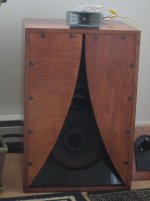
I lost all pictures of it, but I also made mini Smith horns that did well on Karlsons.
Here's a whacky contraption: a huge front-horn compression-loading a Fostex FF125K. Its sensitivity was so high that I eventually used both K12 with AD9710 under it to balance the bass. I likely had system sensitivity over 100dB for 2.83V with this scheme. The horns was high-passed in the lower midrange IIRC and I tried my best to match the low-pass with on-hands components. This was a pretty cool monaural system, though short-lived in my room.

Not all of it is fullrange and 100% on-topic, but this is the one place where Karlson fans seem to hang out most.
I first built a pair of K5 in 2011 or so. These are scaled-down from the factory K8 design. Hard to see in the below picture, but they used a Pioneer A11 4.5" fullrange.

I then purchased the last pair of FF125K at Solen (most likely in all of Canada) before they were discontinued. These were better-suited than the A11, which is a bit of a boring driver itself.


The last configuration I tried with the K5 was a transformation to an X5, with an internal K-tube. The new midbass driver was a 5.25" Vifa C13, which did reasonably well in there with a venting mod. The slotted waveguide was driven by a tiny inexpensive mylar dome tweeter.


Overall, the K5 was not a success. There never was much bass and the sound was usually congested.
I then decided to go larger and built a pair of Karlsonette. This was the first K12 commercialized by Karlson. I built strictly to factory plans. I had two drivers to mess with in there: the 8" Philips AD9710 and 10" Richard Allan CG10T.

The CG10T did somewhat better in the bass, seeing how it has a lower Qt, but needed HF help, already being somewhat soft on top. The AD9710's near 100dB high-frequency sensitivity was well balanced by the BP6 gain on the other hand. These could play really loud in a small room, but would have done better in a larger space.
I also tried a DIY coaxial driver in there, made up of Foster 12" woofer and 1.5" dome tweeter, parted out from Sears Professional enclosures. The high-Qt and Vas of the woofer made it perform horribly in the K12.

I tried many schemed for HF augmentation on top of the K12. Here's an EV T-35, I know, it should have been rotated 90°. 🙂

I lost all pictures of it, but I also made mini Smith horns that did well on Karlsons.
Here's a whacky contraption: a huge front-horn compression-loading a Fostex FF125K. Its sensitivity was so high that I eventually used both K12 with AD9710 under it to balance the bass. I likely had system sensitivity over 100dB for 2.83V with this scheme. The horns was high-passed in the lower midrange IIRC and I tried my best to match the low-pass with on-hands components. This was a pretty cool monaural system, though short-lived in my room.

Last edited:
Ultimately, the best HF scheme was the K-Tube. I was lucky to score a pair of Transylvania Power Company "The Tube". Here is the first stand I made for it with a D220Ti driver.

I then made matching enclosures with and L-pad.
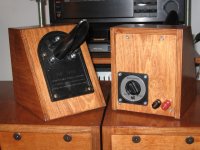
My best overall configuration with the Karlsonette was with a Celestion TF1020 10" midbass driver. It was much better suited to the specific BP6 dimensions/tunings of the K12 than all previous drivers. I lost pictures, but had fabricated an adjustable mount of the K-Tube, pointing down and slot facing up (thanks for the tip GregB!) and used BMS 4550.
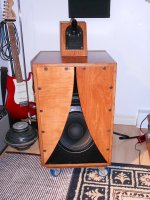
I then decided to try out a build that had been developed by several Karlson forum member back then, the Super-K8, SK8 for short. It actually is about a K10 if going by classic scale-down ratio. I only had my Philips AD9710 to use in there and it did rather poorly in the small Vb.
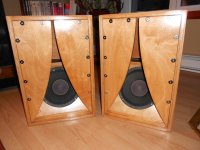
I decided to purchase a pair of Fostex FF225WK. This driver did much better with its lower Qt. I would also have liked to try the old FF225K if it had still been available.
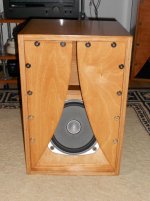
Being a whizzer-less 8", it also needed help on top. I made small conical plywood waveguides to use on it with a P.Audio BM-D440.

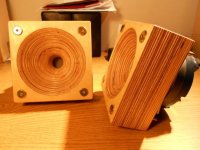
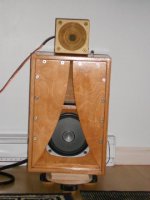
I also used the mini Smith horns on there a lot, they did well. I never tried the K-Tube on the SK8 though.
Here's a group shot of K5, SK8 and Karlsonette for scale.
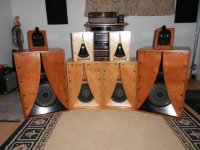

I then made matching enclosures with and L-pad.

My best overall configuration with the Karlsonette was with a Celestion TF1020 10" midbass driver. It was much better suited to the specific BP6 dimensions/tunings of the K12 than all previous drivers. I lost pictures, but had fabricated an adjustable mount of the K-Tube, pointing down and slot facing up (thanks for the tip GregB!) and used BMS 4550.

I then decided to try out a build that had been developed by several Karlson forum member back then, the Super-K8, SK8 for short. It actually is about a K10 if going by classic scale-down ratio. I only had my Philips AD9710 to use in there and it did rather poorly in the small Vb.

I decided to purchase a pair of Fostex FF225WK. This driver did much better with its lower Qt. I would also have liked to try the old FF225K if it had still been available.

Being a whizzer-less 8", it also needed help on top. I made small conical plywood waveguides to use on it with a P.Audio BM-D440.



I also used the mini Smith horns on there a lot, they did well. I never tried the K-Tube on the SK8 though.
Here's a group shot of K5, SK8 and Karlsonette for scale.

Here are a couple of the saner Karlson schemed I though of and drafted through the years.
I had once built a BK10 BLH for Fostex FF125K, out of foam core, before it was all the rage. 😉 I thought to make a K-TL type enclosure using the BK10 as a basis and transformed its dimensions as best as I could in the Karlsonized BK10, which is more along the line of some of the modern small K designs.
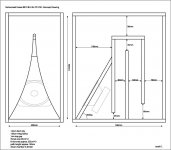
I also wanted to modify the SK8 to a smaller form-factor for use with low Qt and Vas 8" pro midbass and coax drivers.
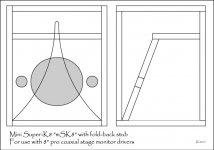
Neither were ever built.
I took tons of measurements on all of the builds I posted, but lost all images of them to Imageshack and a hard-drive crash, so nothing posted here.
I don't own any of the Karlsons anymore, only the TPC tubes. I re-built the K5 into a standard sealed box for the Vifa C13 and gave them away. I sold the Karlsonettes with the AD9710 in them, along with the conical wood waveguides and the mini-Smith horns. I used the SK8 box to experiment with other audio stuff and eventually dismantled it, I probably have the planks somewhere in my garage.
I liked how the Karlsons reproduced classical music, Jazz, electronica and instrumental in general, but was never able to make them sound the way I like for rock and pop music. I have mostly worked with constant-directivity pro-driver based 2-ways since, as well as fullrange in more standard enclosures. I kind of lost interest in hi-fi for a few years, mostly since I had settled on my various systems, happy with them and was focusing on the music itself more than the gear.
I had once built a BK10 BLH for Fostex FF125K, out of foam core, before it was all the rage. 😉 I thought to make a K-TL type enclosure using the BK10 as a basis and transformed its dimensions as best as I could in the Karlsonized BK10, which is more along the line of some of the modern small K designs.

I also wanted to modify the SK8 to a smaller form-factor for use with low Qt and Vas 8" pro midbass and coax drivers.

Neither were ever built.
I took tons of measurements on all of the builds I posted, but lost all images of them to Imageshack and a hard-drive crash, so nothing posted here.
I don't own any of the Karlsons anymore, only the TPC tubes. I re-built the K5 into a standard sealed box for the Vifa C13 and gave them away. I sold the Karlsonettes with the AD9710 in them, along with the conical wood waveguides and the mini-Smith horns. I used the SK8 box to experiment with other audio stuff and eventually dismantled it, I probably have the planks somewhere in my garage.
I liked how the Karlsons reproduced classical music, Jazz, electronica and instrumental in general, but was never able to make them sound the way I like for rock and pop music. I have mostly worked with constant-directivity pro-driver based 2-ways since, as well as fullrange in more standard enclosures. I kind of lost interest in hi-fi for a few years, mostly since I had settled on my various systems, happy with them and was focusing on the music itself more than the gear.
Last edited:
those were the daze (especially with the late and great Gregg Baker) ! my "Super K8" has run FE206E (nice), Delta 8A with K-tube - powerful for an 8" (including the beautiful brass tubes you gave to me 😀) and W8-1772 which sounded very good - I liked 1772 in that size better than in the Karlsonette 1st K12. Also, the fast taper aperture is a good option.
there was not a lot of change in system resonance going from the faster opening aperture to standard radial arc -
perhaps due to the vent's ~central placement. A higher vent might have shown more difference.

I really like K12 with certain drivers and will probably return to it for Kappa12a with a single K15 style vent. K12 with pym1298 and topped with a K-tube has more "grab" than my Klipschorns - might be just balance but its seems quite powerful for its size and I prefer it also to FH1 . I have a Beyma 12cx in a slit vent factory K12 and should get back to it to see what can be done as its woofer seems superior to the Beta 12CX.
K15 was a brilliant design and still a great speaker and can equal or beat a lot of horns its size. It can play at amazing volumes and cone not seem to move - same with K12 and even K10 size. K8 were tuned near 95Hz (an octave higher than K15) and would need a sub. Art Welter's Dad's diy K8 based on K12 are better (and somewhat larger) than my factory K8
K's curved reflector is something to work on - I suspect it can be very good or possibly exacerbate problems (?)
I also don't know about using higher aspect - Karlson's original aspect seemed to maximize "hit".
depending upon Vas, and mass, Qts can bee too low in smaller couplers = K12 did pretty well with 12pe32 which
has old-school horn parameters. I pick Kappa12a for a bit more Xmax and output on the bottom. I have an old spec Eminence B102 iwhose Qts measures 0.23 in a slit vent K12 and its great - not too lean.
there was not a lot of change in system resonance going from the faster opening aperture to standard radial arc -
perhaps due to the vent's ~central placement. A higher vent might have shown more difference.

I really like K12 with certain drivers and will probably return to it for Kappa12a with a single K15 style vent. K12 with pym1298 and topped with a K-tube has more "grab" than my Klipschorns - might be just balance but its seems quite powerful for its size and I prefer it also to FH1 . I have a Beyma 12cx in a slit vent factory K12 and should get back to it to see what can be done as its woofer seems superior to the Beta 12CX.
K15 was a brilliant design and still a great speaker and can equal or beat a lot of horns its size. It can play at amazing volumes and cone not seem to move - same with K12 and even K10 size. K8 were tuned near 95Hz (an octave higher than K15) and would need a sub. Art Welter's Dad's diy K8 based on K12 are better (and somewhat larger) than my factory K8
K's curved reflector is something to work on - I suspect it can be very good or possibly exacerbate problems (?)
I also don't know about using higher aspect - Karlson's original aspect seemed to maximize "hit".
depending upon Vas, and mass, Qts can bee too low in smaller couplers = K12 did pretty well with 12pe32 which
has old-school horn parameters. I pick Kappa12a for a bit more Xmax and output on the bottom. I have an old spec Eminence B102 iwhose Qts measures 0.23 in a slit vent K12 and its great - not too lean.
Last edited:
hey IG81 - someone ought to give the K-ized blh hybrid a try - can you fudge it with hornresp? - that could be interesting with FE206EN although, FE206EN played very well in the 1954 K12. How about a 12" driver version tuned for a balance of punch and extension hoping to keep cone excursion minimized while getting some extension beyond a standard K12 ? ((MMJ may be working on a 15" ParaKoupler for one of my B&C 15)
If "diffraction" is such a horrible thing, why does the K-tube (in its usable range) sound superior to many dome, horn and waveguide?
If "diffraction" is such a horrible thing, why does the K-tube (in its usable range) sound superior to many dome, horn and waveguide?
Last edited:
Here's about the best I can approximate the K-BK10 in HR. I don't recall ever simulating it. Using the Tapped Horn model is as close as I can think to do K's in HR.
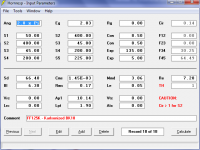
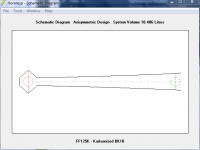
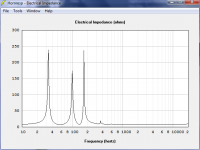
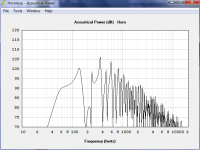
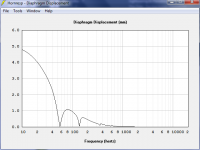
Overall, the simulation is comparable in TH mode (Karlsonized) and Nd (BK10 BLH) mode, in that they're both fairly horrible. 🙂 I don't see and advantage to the K-BK10 in this very specific situation.
________________
Here's a few measurements I still have on K-Tubes.
Impedance of an Emilar EC175 naked versus with TPC tube:
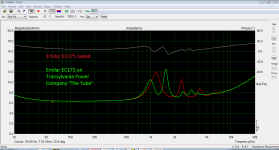
Impedance of a 5.3" unslotted tube on EC175, versus same with added K-Tube on the end:
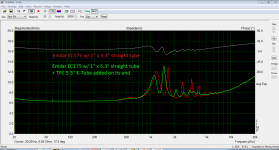
FR of TPC tube on EC175, done at less than 1m IIRC, possibly 30-50cm:
blue: naked
red: with tube
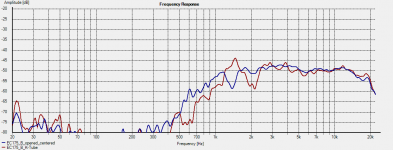
FR and distortion of TPC tube on BMS 4550, done at less than 1m IIRC, possibly 30-50cm:
blue: naked
red: with tube
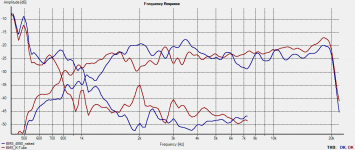
On the EC175 FR trace, I'm not certain why the low-end is diminished with the Tube on, it may have been diaphragm clamping issues one driver had. Still, note the dip at 2kHz.
On the 4550 FR trace, a similar dip and rise in distortion is seen around 2kHz. There appears to be some loading from 700Hz to 1500Hz, as there is more output and a reduction in distortion. There seems to be a rise in distortion above this though.





Overall, the simulation is comparable in TH mode (Karlsonized) and Nd (BK10 BLH) mode, in that they're both fairly horrible. 🙂 I don't see and advantage to the K-BK10 in this very specific situation.
________________
Here's a few measurements I still have on K-Tubes.
Impedance of an Emilar EC175 naked versus with TPC tube:

Impedance of a 5.3" unslotted tube on EC175, versus same with added K-Tube on the end:

FR of TPC tube on EC175, done at less than 1m IIRC, possibly 30-50cm:
blue: naked
red: with tube

FR and distortion of TPC tube on BMS 4550, done at less than 1m IIRC, possibly 30-50cm:
blue: naked
red: with tube

On the EC175 FR trace, I'm not certain why the low-end is diminished with the Tube on, it may have been diaphragm clamping issues one driver had. Still, note the dip at 2kHz.
On the 4550 FR trace, a similar dip and rise in distortion is seen around 2kHz. There appears to be some loading from 700Hz to 1500Hz, as there is more output and a reduction in distortion. There seems to be a rise in distortion above this though.
Last edited:
that's quite a rise in distortion right where response is dipping - wonder what's happening ? IIRC, I've sen pretty low distortion but sometimes high when a driver's coil was not clearing the gap right. I saw a response notch on a tube of mine when a short stub was added.
A bit more K-Tube data I dug out from a folder.
This is the small BMS 4540ND 1" driver on TPC Tube, JBL 6" PT waveguide and DIY 700Hz Tractrix horn. The red trace is the unloaded driver.
TPC "The Tube":
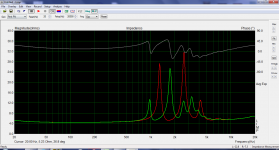
JBL 6" PT waveguide (what I use them on currently BTW, over a Peerless 8" Nomex MLTL):
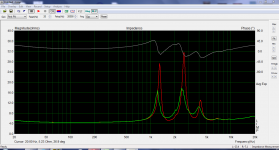
DIY 700Hz Tractrix:
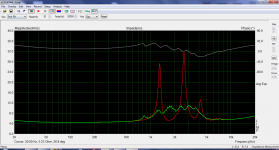
Clearly the horn damps best overall, not surprising. The CD-WG damps a bit with hardly a change in peak/valley location. I'm not too certain how to interpret the TPC's trace, but I think different frequencies see the progressive slot as different termination lengths, thus introducing new peaks/valleys.
This is the small BMS 4540ND 1" driver on TPC Tube, JBL 6" PT waveguide and DIY 700Hz Tractrix horn. The red trace is the unloaded driver.
TPC "The Tube":

JBL 6" PT waveguide (what I use them on currently BTW, over a Peerless 8" Nomex MLTL):

DIY 700Hz Tractrix:

Clearly the horn damps best overall, not surprising. The CD-WG damps a bit with hardly a change in peak/valley location. I'm not too certain how to interpret the TPC's trace, but I think different frequencies see the progressive slot as different termination lengths, thus introducing new peaks/valleys.
Last edited:
one thin about K-tube - since its area is typically small, I think is can help to have a baffle at the driver exit plane when using one on top of a cabinet. Cardboard can be used to determine what works well.
Member
Joined 2020
Here's a Karlson enclosure for sale on Craigslist Karlson Enclosure Cabinet X-15 Vintage Audio Wood Box 15 Inch... and eBay Karlson Enclosure Cabinet X-15 Vintage Audio Wood Box for 15 Inch Speaker | eBay
Built around 1954. Purchased used in around 1965.Overall size is approx. 34" H x 23" W x 18" D. Included internal speaker size is unknown (possibly 12" or 15").
Weight is approx. 85 lbs.; Shipping Weight is approx 97 lbs.
$200 or best offer. Pick up in Anaheim, CA or pay for all shipping and handling. Corey 562-980-6013
Built around 1954. Purchased used in around 1965.Overall size is approx. 34" H x 23" W x 18" D. Included internal speaker size is unknown (possibly 12" or 15").
Weight is approx. 85 lbs.; Shipping Weight is approx 97 lbs.
$200 or best offer. Pick up in Anaheim, CA or pay for all shipping and handling. Corey 562-980-6013
IG81, could you please make some detailed measurements and maybe pictures, so that the Transylvania tube could be reproduced as a 3D printed thing? I made some trials here: 3D printed K-Tube for 1" compression drivers
Hi pelanj,
I do not have the K-Tubes anymore, so I can't help out much other than saying your 3D model seems accurate enough, any deviation from the TPC unit will likely be insignificant. The only thing of note on the TPC "The Tube" is that it seems to have a very slight taper from base to tip, most likely for de-molding purpose as I believe it was cast and not machined.
I haven't been doing much in the way of audio for a few years and missed your (as well as ReinoutdV's) K-tube experiments. IMO they can be very good and probably the best thing to come out of everything Karlson. I've had a mind to perhaps make another one for fun.
I do not have the K-Tubes anymore, so I can't help out much other than saying your 3D model seems accurate enough, any deviation from the TPC unit will likely be insignificant. The only thing of note on the TPC "The Tube" is that it seems to have a very slight taper from base to tip, most likely for de-molding purpose as I believe it was cast and not machined.
I haven't been doing much in the way of audio for a few years and missed your (as well as ReinoutdV's) K-tube experiments. IMO they can be very good and probably the best thing to come out of everything Karlson. I've had a mind to perhaps make another one for fun.
- Home
- Loudspeakers
- Full Range
- My experience with Karlson enclosures
